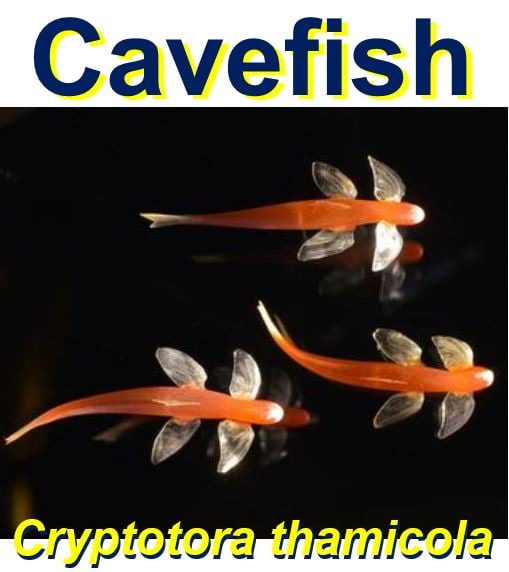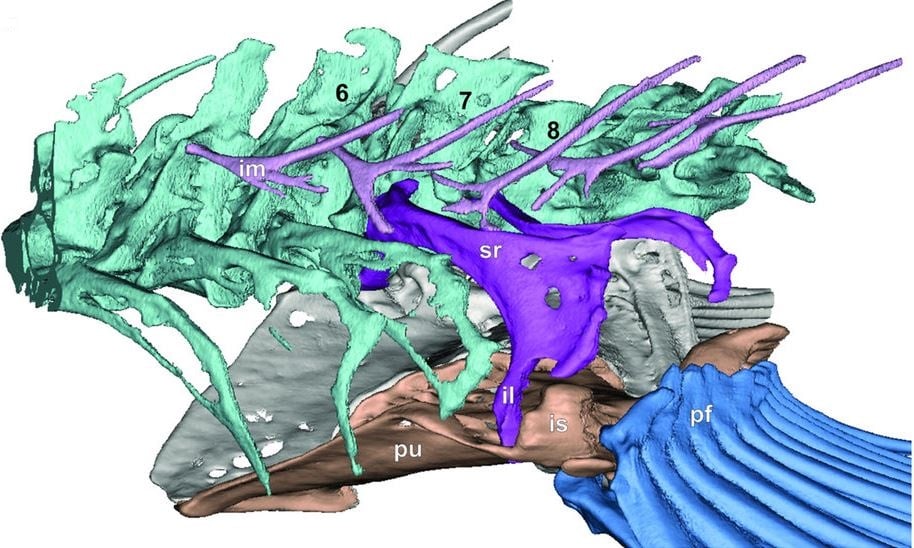A walking blind species of cavefish discovered in Thailand will provide scientists with clues on how, during evolution, creatures made the transition from swimming in water to walking on land. Life on Earth is believed to have started in water, and then over hundreds of millions of years, made its way onto land.
This cavefish, scientifically known as Cryptotora thamicola, can walk with amazing agility for a fish. To the untrained eye, one could be forgiven for confusing it with a lizard or salamander-type creature.
A team of scientists from the New Jersey Institute of Technology (NJIT) wrote in the journal Nature Scientific Reports that Cryptotora thamicola walks on land as well as several tetrapods – 4-footed mammals and amphibians.
 Like many cave-dwelling animals that live in caves, Cryptotora thamicola lacks eyes and skin pigment. However, this one uses its front and back fins to walk up waterfalls. (Image: American Museum of Natural History)
Like many cave-dwelling animals that live in caves, Cryptotora thamicola lacks eyes and skin pigment. However, this one uses its front and back fins to walk up waterfalls. (Image: American Museum of Natural History)
Study leader, Brooke Flammang, assistant professor at the NHIT’s Fluid Locomotion Laboratory, explained that there are other fish species that use their fins to ‘walk’ about on the sea bed, generally with a fundamental hopping movement.
Cryptotora thamicola in world of fishes
However, this cavefish is completely different, because it can get out of the water, climb up steep rock faces with water falling on it (from a waterfall) – using its fins and wiggling. It can get about on land with virtually the same agility as a newt or salamander.
The researchers were fascinated by this fish’s lifestyle. They have no eyes, but manage to find each other in a fast-flowing water environment, and to catch food to stay alive. How do they do this?
 No other species of fish is able to move about as easily on land as in the water. (Image: YouTube)
No other species of fish is able to move about as easily on land as in the water. (Image: YouTube)
The discovery of this amazing capability, never observed before in modern fishes, can also help us better understand how the bodies of all animal species evolved as their fins gave way to limbed appendages during the Devonian period, which began approximately 420 million years ago.
In a video that the researchers took of the fish’s unique movements (at bottom of page), you can see how it twists its body from side-to-side, using its rear and front fins to take steps up the face of a waterfall.
Fish with tetrapod features
Prof. Flammang said:
“It possesses morphological features that have previously only been attributed to tetrapods. The pelvis and vertebral column of this fish allow it to support its body weight against gravity and provide large sites for muscle attachment for walking.”
“This research gives us insight into the plasticity of the fish body plan and the convergent morphological features that were seen in the evolution of tetrapods.”
 Anterolateral view of Cryptotora thamicola’s pelvic girdle. il, iliac region (dark purple); im, intermuscular bone (light purple); is, ischial region of puboischiadic plate (tan); pf, pelvic fin (blue); pu, pubic region of puboischiadic plate (tan); sr, sacral ribs (dark purple). Vertebrae numbers 6,7,8 designate position from skull. (Image: nature.com)
Anterolateral view of Cryptotora thamicola’s pelvic girdle. il, iliac region (dark purple); im, intermuscular bone (light purple); is, ischial region of puboischiadic plate (tan); pf, pelvic fin (blue); pu, pubic region of puboischiadic plate (tan); sr, sacral ribs (dark purple). Vertebrae numbers 6,7,8 designate position from skull. (Image: nature.com)
The authors made the following comment in an Abstract in the journal:
“These findings are significant because they represent the first example of behavioural and morphological adaptation in an extant fish that converges on the tetrapodal walking behaviour and morphology.”
Citation: “Tetrapod-like pelvic girdle in a walking cavefish,” Apinun Suvarnaraksha, Daphne Soares, Brooke E. Flammang & Julie Markiewicz. Nature Scientific Reports. 24 March 2016. DOI: 10.1038/srep23711.
Video – Cryptotora thamicola: a cavefish with evolutionary implications
The researchers were amazed when they discovered a fish that specialises in waterfalls. In complete darkness they stick to the rock, and climb waterfalls up the rock face.
